In 2021, the average training budget for large companies was $17.3 million, while midsize companies spent $1.3 million. When organizations are looking for cost optimization, it's important to ensure the money spent on learning is an investment with visible results. Formal training has been the main focus of corporate learning and development (L&D) for a long time, but now priorities are beginning to shift to accommodate employee preferences. Around 68% of employees prefer to learn or train in the workplace and 58% of employees prefer to learn or train at their own speed. What is clear is that learners prefer more autonomous learning in the workplace, and taking this into consideration leads to better engagement and training ROI.
What is learner autonomy?
Learner autonomy, or autonomous learning, is closely tied to the concept of self-directed learning (SDL), which dates back to Malcolm Knowles' studies on self-directed andragogy. He defined it as "a process in which individuals take the initiative without the help of others in diagnosing their learning needs, formulating goals, identifying human and material resources, and evaluating learning outcomes."
Today, this concept is even more relevant, as adult learners want to have control of their training and development.
Key benefits of learner autonomy for corporate learning
- Increased engagement: When employees have autonomy, they are more likely to be engaged and motivated. This can lead to higher levels of interest and enthusiasm for the learning process, resulting in better retention of information and skills.
- Fosters creativity and innovation: Empowering employees to explore topics of interest and pursue self-directed learning can stimulate creativity and innovation within the organization.
- Flexibility and adaptability: Learner autonomy allows employees to learn at their own pace and on their own schedule, which is particularly important in today's fast-paced and dynamic business environment.
- Continuous learning culture: When employees are encouraged to take ownership of their learning and pursue ongoing development opportunities, it sends a powerful message that learning is valued and supported at all levels of the organization.
- Improved performance and productivity: When individuals have the knowledge and skills they need to excel in their roles, they are better equipped to contribute to the overall success of the organization.
Why is learner autonomy important for corporate learning?
L&D departments have had to adjust and transform tremendously in the past decade. First, the digital revolution has moved much of the learning online, then the pandemic moved much of the workforce out of the office. The subsequent workforce realignment placed extra strain on the employees as well as the L&D departments.
In addition to much of the workforce shifting online, new technologies, governmental changes, and shifting industries are bringing what is now known as a “new era of turbulence,” according to the World Economic Forum’s Future of Jobs Report. This era calls for a more resilient workforce with upskilling, cross-skilling, and reskilling at the forefront of building resilience.
In a recent survey of 400 HR and business leaders across the US and UK, 40% of respondents said talent retention and staff well-being are their two priorities for 2024, and 35% said upskilling is their top priority.
Autonomous learning benefits all aspects of an organization. Specifically, when it comes to talent retention, employees are drawn to companies that support their personal and professional development, trust in their decision making and priorities, and provide opportunities for growth and advancement. Offering autonomy in learning demonstrates a commitment to employee development and empowerment.
Learner autonomy also encourages a culture of innovation and creativity within the organization. When employees are encouraged to explore new ideas and approaches independently, they are more likely to contribute fresh perspectives and innovative solutions to business challenges. This not only enhances the organization's competitiveness but also fosters a sense of fulfillment and purpose among employees.
Adult learners want self-direction
SDL has many facets, yet the critical element is an individually motivated desire to learn. E-learning is the optimal format for SDL since it allows for more flexibility and integration of various learning content formats to accommodate a wide array of learning preferences. However, which learning platform you adopt greatly affects the effectiveness of your learning program.
In today's globalized workforce, it's essential that learning platforms facilitate collaboration and connectivity across geographical boundaries, connecting people who speak different languages. Features such as universal translators, discussion forums, and social learning communities enable learners to engage with peers, mentors, and trainers across your organization, fostering a rich learning experience.
Challenges of implementing autonomous learning
Autonomous learning challenges for learners range from limited access to resources to the absence of structured evaluation processes. Learners may encounter difficulties in finding credible learning materials, managing their time effectively, maintaining motivation without external supervision, and more.
- Lack of time: Let’s face it. Everyone feels overwhelmed at work sometimes and trying to integrate self-directed learning on top of work stress can be a challenge. Especially when the learning programs feel like a burden, chore, or have a steep learning curve.
- Access to resources: Autonomous learning requires access to relevant learning resources, such as courses, online tutorials, and mentors. Not all employees may have equal access to these resources, which can hinder their ability to engage in self-directed learning.
- Skill and motivation: Some employees may struggle with self discipline, time management, or learning independently without direct guidance. Without personalized learning paths or courses, some employees may fall through the cracks.
- Lack of feedback and accountability: Without proper feedback mechanisms and accountability structures in place, employees may struggle to assess their progress and stay motivated in their learning journey. They may also lack guidance on how to adjust their learning strategies based on feedback.
- Integration with workflows: Integrating autonomous learning into existing workflows and processes can be challenging. Employers need to find ways to align self-directed learning with organizational goals, objectives, and existing tools while ensuring it doesn't disrupt daily operations.
- Evaluation and recognition: Traditional performance evaluation systems may not effectively measure the impact of autonomous learning on employee performance and development. Organizations must lean into new methods for evaluating and recognizing the skills and knowledge gained through self-directed learning, such as competency-based learning.
How can companies support autonomous learning in the workplace?
Companies have a lot to gain if employees embrace learner autonomy. Intrinsically motivated learners give organizations an excellent competitive advantage in the market. Autonomous learning not only enhances employee engagement, but it can also accelerate skill development, increase adaptability and innovation, improve talent retention, save money, and more. But to get there, organizations need to take steps to ensure the work environment is conducive to continuous learning. Here are some ideas:
Learning programs that look to the future
Long-term thinking means more than bridging present skills gaps. The "quick fix" method, where learning is solely deployed to close urgent learning gaps, is not a winning one. Learning initiatives should prioritize building foundational skills that are transferable across roles and industries, rather than just providing quick fixes for current needs.
Companies should partner with learning platforms that demonstrate a commitment to ongoing innovation and adaptation to changing circumstances. This ensures that employees have access to the most relevant and up-to-date learning resources as the landscape evolves. It also promotes a continuous learning culture.
Choosing the right technology
Don't expect employees to take control of their development while providing sub-par or outdated learning platforms. Selecting the appropriate learning technology is crucial for supporting autonomous learning in the workplace. Companies should invest in modern, user-friendly platforms that facilitate personalized learning experiences.
The chosen platform should offer features such as AI-driven recommendations, adaptive learning paths, and diverse content formats to cater to different learning preferences. It should also provide robust tracking and analytics capabilities, allowing companies to monitor learner progress, identify areas for improvement, and measure the impact of learning initiatives.
Integration with other systems and tools used within the organization, such as HR software and performance management systems, can further streamline the learning experience and enhance its effectiveness.
Fostering a positive company culture
Cultivating a positive company culture that values learning, growth, and experimentation is essential for supporting autonomous learning. Companies should promote a growth mindset where mistakes are viewed as opportunities for learning and development rather than failures to be punished.
Encouraging open communication, collaboration, and knowledge sharing among employees fosters a supportive environment where individuals feel empowered to take risks and explore new ideas. Recognition and rewards for learning achievements can further incentivize employees to engage in self-directed learning and contribute to a culture of continuous improvement.
How CYPHER Learning supports autonomous learning in the workplace
CYPHER Learning recognizes the importance of empowering employees to take control of their own development and offers a comprehensive suite of tools and features designed to support autonomous learning in the workplace. From personalized learning paths to advanced AI-powered capabilities, social learning features, real-time analytics, and seamless integration with external resources, CYPHER Learning provides organizations with the necessary infrastructure to foster a culture of self-directed learning and continuous improvement. Discover some of the ways in which CYPHER empowers employees to self-direct their learning.
-
Personalized learning paths: CYPHER enables organizations to create personalized learning paths for each employee based on their skills, goals, and learning preferences. This fosters continuous development and guides learners' progression. With learning goals, employees can set their own objectives and the platform’s intelligent recommendations will direct learners on how to meet them.
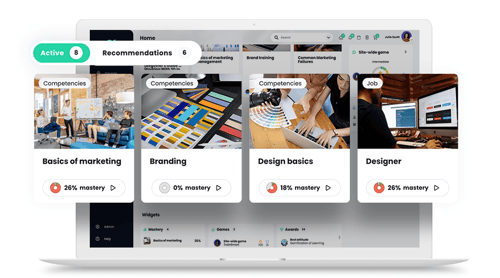
-
Self-paced learning: CYPHER enables self-paced learning, allowing employees to learn at their own speed and convenience. This flexibility is essential for autonomous learning, as it accommodates employees' busy schedules and diverse learning styles.
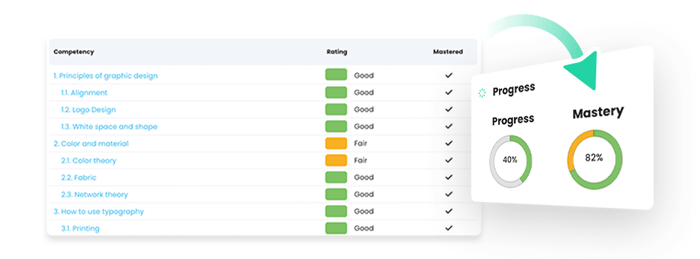
-
Advanced AI-powered capabilities: CYPHER Agent creates competency-mapped and gamified courses in minutes, enabling personalized learning at scale. The AI-powered voiceover turns static lessons into multi-sensory learning experiences to accommodate diverse learning abilities. All of its AI-powered tools are packaged, purposeful, and intuitive, so you can create without any knowledge of AI.
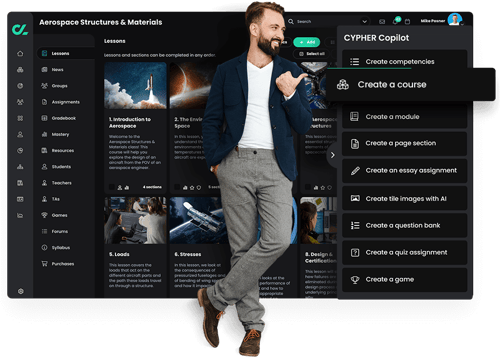
-
Social learning features: The platform includes social learning features such as discussion forums, chat rooms, groups, a real-time universal translator, and more. Plus, it’s the only platform with a “Green dot feature” which pulses and grows based on the number of users currently online, enabling learners to communicate and receive help faster from active users. This facilitates knowledge sharing, peer-to-peer learning, and fosters a sense of community, which is essential for autonomous learning.
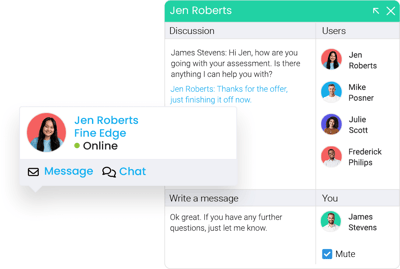
-
Real-time analytics and reporting: CYPHER empowers you to track module progress, learner engagement, and course status, identify areas for improvement, and fine-tune strategies for optimum results. Plus, our innovative reporting widgets showcase custom charts directly on your dashboard for seamless and real-time visibility.
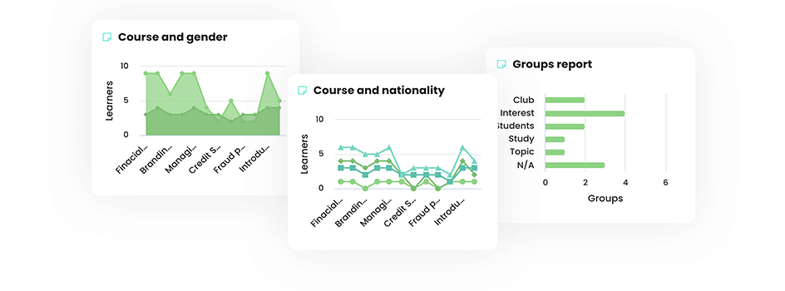
-
Integration with external resources: The platform seamlessly integrates with external learning resources, such as Udemy, Coursera, and Go1. It also offers thousands of enterprise-class integrations for seamless learner enrollment, progress tracking, and more.
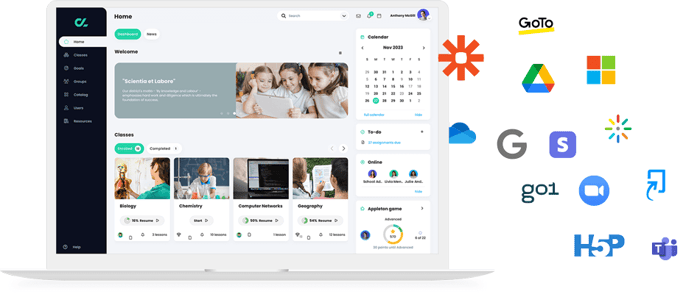
Take a tour of the CYPHER Learning platform and see how it can help you empower your employees to take ownership of their learning.





